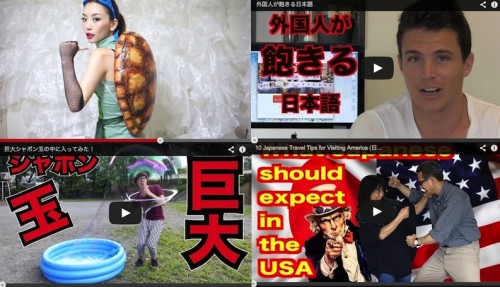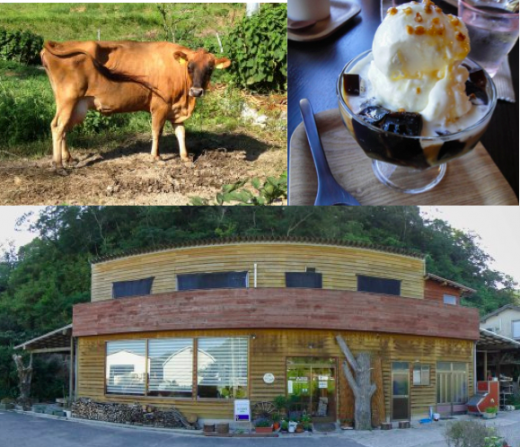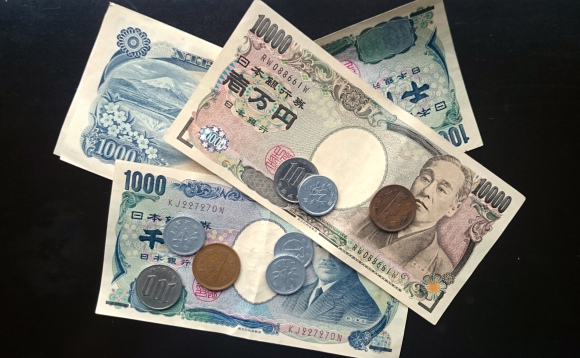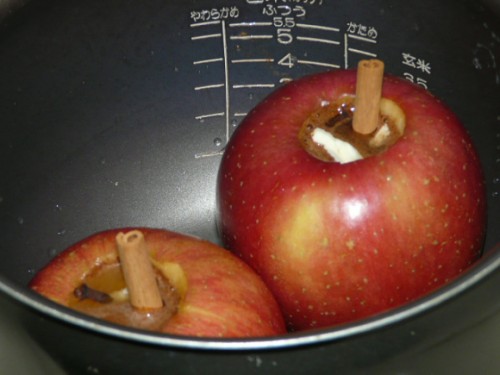JQ Magazine: Book Review — ‘Starting Point: 1979-1996’ by Hayao Miyazaki
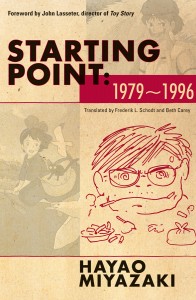
“For those who enjoy the process and precision behind an art, Starting Point is a rare glimpse into an often-times enigmatic industry.” (VIZ Media LLC)
By Alexis Agliano Sanborn (Shimane-ken, 2009-11) for JQ magazine. Alexis is a graduate student of Harvard University’s Regional Studies—East Asia (RSEA) program, and currently works as an executive assistant at Asia Society in New York City.
Starting Point: 1979-1996, translated by Beth Cary and Frederik L. Schodt, is quite unlike its sequel, Turning Point: 1997-2008 (read JQ’s review here). Technical rather than creative, Starting Point shares renowned director Hayao Miyazaki’s recollections of his early days as an animator. The essays and interviews follow anime through production development, touching on the intricacies of character design, layout, and story adaptation. For those who enjoy the process and precision behind an art, Starting Point is a rare glimpse into an often-times enigmatic industry.
The first half of the work features essays on Miyazaki’s long hours in the studio, culture, and nature of Japan’s animation industry in the 1960s and 1970s. As Miyazaki notes, even then, anime was tied to media mix marketing. You didn’t just have manga; you had manga, then an anime, toys, merchandise, and spin-offs all fueling off each other. Says Miyazaki in a 1982 interview: “The world of anime makes its business out of themes like departing for new horizons or love, while pretending not to be conscious of [the] commercial reality.” In hindsight, these remarks prove ironic; the auteur’s Studio Ghibli having similarly succumbed to commercialization.
It isn’t just media mix that remains the same today: professional frustrations were high and work-life balance poor. Miyazaki, over the course of several essays, recounts the life of a young professional. He states: “When young, nearly all of us want to be taken seriously, as soon as possible….In fact, many of those who have not yet taken the plunge into the professional world…tend to speak endlessly about techniques, or concentrate on gaining as much knowledge as possible….In reality, however, once you enter this industry, the techniques required can be mastered very quickly.”
【RocketNews24】Why Japanese doesn’t need swear words
Posted by Michelle Lynn Dinh (Shimane-ken, Chibu-mura, 2010–13), editor and writer for RocketNews24. The following article was written by Casey Baseel, a writer and translator for RocketNews24, a Japan-based site dedicated to bringing fun and quirky news from Asia to English speaking audiences.
The other day, my wife and I spent the day hanging out at the beautiful and awesome Hitachi Seaside Park. As we headed towards the exit at dusk, I pointed to a grove of trees with the sun setting behind them and got to bust out one of my favorite five-dollar Japanese vocabulary words: komorebi.
In retrospect, two things come to mind. First, shouldn’t a five-dollar Japanese word really be a 500-yen word? And second, why is it that the Japanese language has vocabulary as specific as komorebi, meaning “sunlight filtering though trees,” yet doesn’t have a good equivalent for *#&!, %?$!, or even &*!$?
Heads up! The following discussion of profanity contains language that might best be read when you’re not at work or school.
Read more at RocketNews24!
JQ Magazine: JQ&A with Web Entrepreneur Vanessa Villalobos

“If you create businesses based on your own experience and enthusiasms, you’ll never tire of them. Be sure to network with JETAA to stay in touch with people who are interested in Japan.” (Courtesy of Vanessa Villalobos)
By Rafael Villadiego (Nagasaki-ken, 2010-13) for JQ magazine. A member of JETAA New South Wales, Rafael is a collector of words on a journey still searching for a destination, who has a tendency to forget, we are all sometimes like the rain…
Like many JET alums, Vanessa Villalobos (Tochigi-ken, 2000-03) thoroughly enjoyed her time in Japan and was seeking a practical means to maintain that connection upon returning home. Seeking to recapture her experiences on the JET Program and maintain her Japanese language skills after returning to the United Kingdom, she founded the travel/lifestyle/culture site JapaneseLondon.com and the language exchange hub, IsshoniLondon.co.uk.
As an independent businesswoman and entrepreneur, she offers some advice to JQ readers seeking to pursue their own ventures and shares some insight into the trials and tribulations of language exchange. She also offers insider tips to discovering the hidden Japan in London along with the colorful contrasts between the two island nations, her thoughts on the recent vote for Scottish independence, and her take on the UK version of nattō.
How long did you spend on the JET Program and in which prefecture were you placed?
I was a “one-shot” ALT in Tochigi-shi for three years. Tochigi-ken is north of Tokyo and is famed for Nikko, strawberries and gyoza.
How did your time on JET influence the overall design and purpose of the websites?
Japan was endlessly fascinating to me, and I loved teaching Japanese learners of English. Thus, I chose to focus my business endeavors on connections between Japan and England.
IsshoniLondon.co.uk connects private tutors of English to Japanese learners of English. Most of the tutors are ex-JETs. In my intro video on the site, I explain how the kindness of friends and teachers in Japan allowed us teachers to develop an understanding and fondness for Japanese language and culture, and how we hope Japanese people will develop the same fondness of the UK. I am always looking for top-quality tutors, so please do get in touch if you’d like to work as a freelance tutor.
JapaneseLondon.com does what it says on the can! It’s a labour of love and is all about discovering Japanese things in London. It promotes and profiles the individuals, events and businesses that together make up “JapaneseLondon”! There is an events calendar, and I’ve just added a job board. Please do sign up to the newsletter on the site! JapaneseLondon.com can also connect you to a tutor of Japanese here in London!
Do you have any advice for JETs looking to setup similar initiatives in their hometowns?
Just get stuck in—and don’t give up. If you create businesses based on your own experience and enthusiasms, you’ll never tire of them. Staying power is important as it is sooo hard to build your own business from scratch. But it is deeply satisfying at the same time! Be sure to network with JETAA to stay in touch with people who are interested in Japan.
【RocketNews24】Learn Japanese from YouTube: Amp up your listening skills with this four-step guide
Posted by Michelle Lynn Dinh (Shimane-ken, Chibu-mura, 2010–13), editor and writer for RocketNews24. The following article was written by Fran Wrigley, writer and translator for RocketNews24, a Japan-based site dedicated to bringing fun and quirky news from Asia to English speaking audiences.
It used to be that if you were studying a foreign language in your own country, the only listening practice that was easily available to you was hearing your teacher or classmates speak, or listening to the CD that came with your textbook. The first Japanese textbook I ever bought actually came with a cassette tape, which was particularly irritating as it was 2006 and I didn’t even own a Walkman any more.
Then someone invented a website that allowed users to upload short videos for all the world to see. Fast-forward nine years and YouTube is one of the biggest sites on the planet, making it a veritable treasure trove of free online spoken content.
So whether you’re after language lessons, YouTubers who vlog in Japanese, or just want to try watching your cat videos in a foreign language, online videos could be your new secret weapon. The trick is just knowing where to look.
Continue to our four-step guide here!
JET alum’s column on Ebola in USAToday
JET alum Emily Metzgar (Shimane-ken, 1995-93), a professor of journalism at Indiana University, has a column in USAToday this week titled, “Is U.S. ‘stuck on stupid’ on Ebola outbreak?”
If Emily’s name sounds familiar, it’s because she’s also the author of Promoting Japan: One JET at a time, a paper based on surveys of and research on the JET alumni community that attempts to measure return on JET-vestment.
JQ Magazine: Film Review — ‘The Tale of the Princess Kaguya’
By Lyle Sylvander (Yokohama-shi, 2001-02) for JQ magazine. Lyle has completed a master’s program at the School of International and Public Affairs at Columbia University and has been writing for the JET Alumni Association of New York since 2004. He is also the goalkeeper for FC Japan, a New York City-based soccer team.
When one hears the name “Studio Ghibli,” the director Hayao Miyazaki immediately comes to mind. Starting with Nausicaä of the Valley of the Wind in 1984, Miyazaki has continually delivered hit after hit for the past 30 years, making him the most successful contemporary Japanese filmmaker (animated or otherwise). Moviegoers can be forgiven for not recognizing the name of Miyazaki’s partner and Ghibli co-founder Isao Takahata, who tends to operate behind the spotlight. But Takahata is an accomplished animator and filmmaker in his own right.
In the West, he is best known for the extraordinary Grave of the Fireflies (1988), a powerful anti-war epic about the firebombing of Kobe during the Second World War. Roger Ebert considered Fireflies one of the best war films ever made, and it certainly ranks among Studio Ghibli’s greatest efforts, elevating the standards of anime depicting serious subject matter. Takahata’s other films were successful in Japan but received limited distribution in the West—notably the ecologically minded Pom Poko (1994) and the comic strip-inspired comedy My Neighbors the Yamadas (1999). From this selection of titles, it is clear that Takahata can work in a variety of genres with different animation styles. Unlike Miyazaki, he delegates much of the animation work and does not have an immediately recognizable aesthetic.
Last year, both Miyazaki and Takahata announced their retirements. For his swan song, Miyazaki released the controversial The Wind Rises (read JQ’s review here), which managed to receive criticism from both the political left and the right in its treatment of the war. Takahata decided to end his career with a project that he conceived and abandoned 55 years ago: A feature film version of the tenth century folktale The Tale of the Bamboo Cutter. Both films were to be released simultaneously in a show of solidarity, but production delays resulted in a later distribution for Takahata’s film. The film became a big hit domestically, and is now receiving its U.S. release under the title The Tale of the Princess Kaguya in both subtitled and dubbed versions.
【RocketNews24】Clever font sneaks pronunciation guide for English speakers into Japanese katakana characters
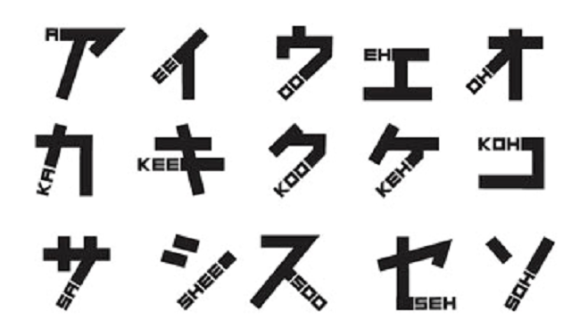
Written Japanese uses three kinds of script. At the top of the difficulty curve, you’ve got kanji, the complex characters originally imported from China that can require over a dozen brush strokes to write, with each kanji representing a word or concept.
A little less challenging are hiragana, a set of 50 curving phonetic characters, but if English is your native language, odds are you’ll have the least trouble with angular katakana. Like hiragana, katakana is a phonetic system, so each character corresponds to a syllable. Even better, while often one kanji can have three or four possible readings, each katakana has just one possible pronunciation.
Of course, you still have to memorize how to pronounce all 50 katakana (85 if you’re being really technical) in the first place. One group of graphic designers are aiming to make that task a little easier, though, with a font that combines katakana with phonetics written in English.
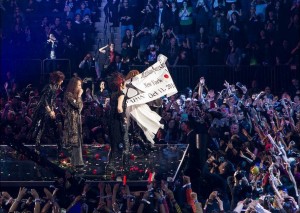
X Japan take a triumphant bow at Madison Square Garden, New York City, Oct. 11, 2014. (Vlad Baranenko)
By Vlad Baranenko (Saitama-ken, 2000-02) for JQ magazine. Vlad is an avid photographer. For his photo gallery of X Japan’s concert at MSG, click here.
On Oct. 11, Madison Square Garden was ignited by the amazing energy of the sensational Japanese rock group X Japan. Realizing a lifelong dream of its founding members—vocalist Toshi and superstar drummer/pianist Yoshiki—X Japan overcame years of behind-the-scenes drama to finally play the World’s Most Famous Arena, as one of the most successful Japanese music groups of all time brought down the house in NYC.
For the first time ever outside of their native Japan, X Japan culminated their dream to perform an all-immersive concert, armed with a full array of fireworks, pyrotechnics, confetti, and incredible light effects. According to Yoshiki in one of many heartfelt messages delivered to the crowd that night, never before their performance at MSG has the group invested so much to awe an overseas audience, which he said was being broadcast live to Japan and other Asian countries.
Playing to a nearly packed arena, the group that started with a dream of two four-year-old boys almost 45 years ago kicked off the show with a pyrotechnic bang, letting the excited audience rock hard to “Jade.” By creating an all-immersive experience for their concert goers, X Japan’s mix of rock and the classical genres appealed to the emotions of young and old attendees alike. For their second appearance in NYC after their legendary show at the now-defunct Roseland Ballroom in 2010, the band’s deep appreciation for their fans’ support rang loud when Yoshiki shared the story of the group’s history and ups and downs. The death of former members Hide and Taiji hit everyone in the group hard, and as Yoshiki spoke about his late friend Hide as still being part of the group, many in the audience shed a tear.
【Exploring Unfamilar Japan】We have dessert and meet a cow named Julia at an organic island café
Michelle Lynn Dinh (Shimane-ken, Chibu-mura, 2010–13) is an editor and writer for RocketNews24, a Japan-based site dedicated to bringing fun and quirky news from Asia to English speaking audiences.
La Cigale is a family-run cafe located in the heart of the largest of the Oki Islands, but it’s much more than a place to get a thoughtful cup of coffee. La Cigale is a hub for the community that supports local events and hosts field trips to teach children about sustainable farming. It’s also a place where neighbor kids gather to help pick vegetables or collect shiitake mushrooms in the nearby mountains. So while we thoroughly enjoyed the coffee parfait we indulged in at La Cigale, we were completely taken with the cafe’s farm-to-table philosophy and the intriguing history of its proprietors.
Read more at RocketNews24
Justin’s Japan: Interview with Yoshiki of X Japan on the Band’s Madison Square Garden Debut
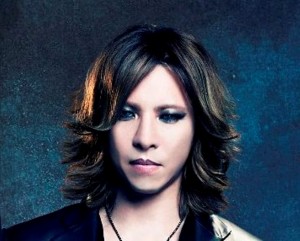
“At an X Japan show, we create a show with the audience—it’s not ‘the band is performing and the audience is just watching,’ so we create the show together. We’re going to try to make Madison Square Garden like a huge club.” (Courtesy of ID PR)
By JQ magazine editor Justin Tedaldi (CIR Kobe-shi, 2001-02) for Examiner.com. Visit his Japanese culture page here for related stories.
For Yoshiki Hayashi, this Saturday (Oct. 11) will go down in J-rock history, as one of the biggest bands in Asia makes their debut at Madison Square Garden. Formed over 30 years ago, X Japan first gained notoriety in the mid-’80s by ushering in the visual kei movement, a style that continues to evolve through other Japanese megastars like L’Arc~en~Ciel (who headlined the World’s Most Famous Arena themselves in 2012).
At the center of it all is X Japan’s founding member, Yoshiki. An equally talented songwriter, heavy metal drummer and classical pianist, he is both the heart and soul of X Japan, and, having lived in Los Angeles for two decades, the ideal mouthpiece for the band’s American tours, which started with a bang in 2010 at Lollapalooza and included a sold-out gig at New York’s now-defunct Roseland Ballroom.
In this exclusive, expansive interview, I spoke with Yoshiki about how the group’s original hopes to play the Garden in 2008 were dashed by personal health and management troubles, his favorite, anime, manga and X Japan songs, and his experience working with legends like Stan Lee, KISS, and the Emperor of Japan.
How did this concert for Madison Square Garden come together? I know there were plans to do this in 2008; can you talk about this history?
Our band reunited around the year 2008. We did our reunion concert in Tokyo Dome, three days or so, I think. At that time, we were also thinking of performing [shows] outside of Japan, and Madison Square Garden was one or two of [the ideas]. But for some reason they didn’t happen, so since then, that venue was always in our minds. A few years ago, we decided to try schedule Madison Square Garden. I think we were kind of confirmed last year.
It’s a long road.
Yes. Well, considering that X Japan was not doing anything—I mean, the band broke up around the end of 1997, so when we reunited we had almost 10 years of a break. We started doing a bunch of arena shows, and then we started touring the world when we went to 16 countries or so. Considering this, the [last] six or seven years have been tours [laughs].
Are there plans for X Japan to play any other concerts for the remainder of the year?
Not now. We just announced our shows in Japan, this place called Yokohama Arena, so we [performed] there Sept. 30 and Oct. 1. It’s kind of like a prelude to Madison Square Garden and a kickoff to [that] show, about 10 days before that. As of now, Madison Square Garden is the only American show, but [depending] on how it goes, we may start another world tour. We’re just talking about it right this moment.
For the complete story, click here.
【RocketNews24】New tax exemption system for foreign visitors to Japan starts today!
Posted by Michelle Lynn Dinh (Shimane-ken, Chibu-mura, 2010–13), editor and writer for RocketNews24. The following article was written by Jessica, a writer and translator for RocketNews24, a Japan-based site dedicated to bringing fun and quirky news from Asia to English speaking audiences.
If you are a regular RocketNews24 reader, you may already know that there have been a lot of changes to Japan’s consumption tax system this year. For those of us who live here, it’s meant an annoying price hike for nearly everything, but for visitors, there is some good news.
Starting today, October 1, new rules regarding consumption tax exemptions for foreign visitors go into effect, and for once, these are actually changes that work in your favor. More details after the jump.
Justin’s Japan: Nippon in New York — Studio Ghibli, New York Comic Con, X Japan, Hatsune Miku

Catch the New York premiere of Studio Ghibli’s “The Tale of Princess Kaguya” at IFC Center Oct. 3. (GKIDS)
By JQ magazine editor Justin Tedaldi (CIR Kobe-shi, 2001-02) for Examiner.com. Visit his Japanese culture page here for related stories.
The Japan-centric events of the month ahead promise to be as rich and full as autumn itself—brisk and colorful, with a dash of unpredictability.
This month’s highlights include:
Friday, October 3, 6:30 p.m.
IFC Center, 323 Avenue of the Americas
$14
New York premiere! Legendary Studio Ghibli co-founder Isao Takahata (Grave of the Fireflies, Pom Poko) revisits an ancient Japanese folktale in this gorgeous, hand- drawn masterwork decades in the making. Found inside a shining stalk of bamboo by an old bamboo cutter (James Caan) and his wife (Mary Steenburgen), a tiny girl grows into an exquisite young lady (Chloë Grace Moretz). The beautiful princess enthralls all who encounter her—but ultimately she must confront her fate. The film will have a “sneak preview” screening in Japanese at IFC Center on Thursday, Oct. 16 prior to its regular run Oct. 17. Click here for additional showtimes.
Sunday, Oct. 5, 4:00 p.m.
Best Buy Theater, 1515 Broadway
$42
The 10-member Morning Musume ’14, also known as Momusu, are one of the most successful Japanese all-girl idol groups, produced by the famous rock writer-producer Tsunku. Their music style is poppy and upbeat, matched only by their elaborately choreographed dance performances. Their story began in 1997 after a TV audition and they made their major debut in 1998.The following year, their single “Love Machine” was their first to sell over one million units. Morning Musume ’14 have already performed in China, Taiwan, South Korea, France and the USA (Los Angeles), and are poised to make their New York stage debut.
Sunday, Oct. 5, 7:00 p.m.
Peter Jay Sharp Theatre at Symphony Space, 2537 Broadway
$40/$30 members, students and seniors/$22 children
Experience the thunderous rhyhms of the ancestral Japanese taiko drums and the magical sounds of the bamboo flutes, as Taikoza returns with richly authentic performances and colorful Japanese dances. The international touring taiko group, led by Swiss-born director Marco Lienhard, will present new compositions as well as traditional pieces in this unique concert featuring special guest from Japan Ichiro Jishoya, who was recently featured in the documentary film Drum Out the Drum of Happiness – Inclusion. This concert will celebrate the 150 anniversary of the diplomatic relationship between Switzerland and Japan.
For the complete story, click here.

“Hopefully the lines between my actual experiences and pure fiction are seamless. When readers ask me, ‘Is this part true?’ they seem surprised by the answers. So that makes me happy—the fiction is believable and sometimes the outrageous is the truth.” (Courtesy of William Fraser)
By Rafael Villadiego (Nagasaki-ken, 2010-13) for JQ magazine. A member of JETAA New South Wales, Rafael is a collector of words on a journey still searching for a destination, who has a tendency to forget, we are all sometimes like the rain…
Laurie Fraser (Osaka-fu, 1997-98) is a writer and traveler who married a Kurd in Turkey in the 1990s. The experience inspired The Word Not Spoken, semi-autobiographical debut novel that blurs the line between reality and fiction, casting light on a tumultuous period in history through the eyes of those who experienced it firsthand.
The conflict between the PKK [Kurdistan Workers’ Party] and the Turkish Armed Forces has its roots in the First World War and continues to have repercussions for the region to this day. But beyond these grand struggles are the quiet moments in between: The ordinary challenges and trivial frustrations of everyday life, and the more overarching issues of culture and religion, which Fraser approaches with a genuine curiosity and gentle humor that forms the emotional core of her book.
An extensive traveler to a number of different countries across the globe, Fraser has experienced life in the broadest context before eventually finding her way “home.” Now a teacher and healer in Ottawa, JQ caught up with her to discuss the events of her life that inspired the novel and how they contrasted with her time on the JET Program.
What led you to first write this novel, and why did it take so long for the finished work to see light?
The scene where Ahmet and Leigh meet a group of destitute Kurdish refugees is exactly true, except that it happened in 1996, not 1995. I decided then to write a book and tell their story in a way that wasn’t “bad news.” At that time, my husband believed that the world would never hear about the Kurds if the PKK wasn’t setting off bombs. I recognized that as a Canadian, I had a right that he did not—the right to free speech.
I am a poet at heart, and I found a novel to be unwieldy to say the least. I had the poet’s need to touch every word over and over—so that slowed me down.
The Word Not Spoken was refused by countless publishers—I had a stack of rejection letters collected just in the year I was in Japan. It did well in a Canadian national writing contest in 2000, but only the winner was published. I was incapacitated with illness for a few years, but I eventually did a huge rewrite in 2010-11 with a professional editor. The manuscript did get better and better over the years, but it wasn’t until self-publishing became accessible and respected that I finally decided to go for it on my own.
I promised those refugees and my husband (who was killed in 1997) that I would publish their stories and really, it was a stone in my stomach for 18 years.
Kurdish House in Vancouver flew me out there (from Ottawa) to read to a large Kurdish audience this past spring. Afterwards, men and women came to talk to me: “I lived in one of those tents for four years.” “I was tortured 45 days.”
I have been haunted by the refugees I met living in those tents in 1996. I couldn’t imagine how any of them would have survived. These Vancouverites were an affirmation of life—some of them had made it! Some of them would have been children in 1996…and here they were! All I could say was, “I’m so glad you got here. I prayed for you.” And indeed, I wrote a book for them.
Justin’s Japan: J-Rocktober
By JQ magazine editor Justin Tedaldi (CIR Kobe-shi, 2001-02) for Shukan NY Seikatsu. Visit his Examiner.com Japanese culture page here for related stories.
This October is set to be a landmark month for New York City, as it welcomes to the stage some of the most celebrated Japanese musicians performing today.
Things kick off on Oct. 5 with girl group Morning Musume ’14 at the Best Buy Theater. The forerunner to today’s mega-member pop acts like AKB48, Momusu has been spinning off hits since 1997, launching the career of songwriter-turned-record mogul Tsunku in the process.
On Oct. 11, X Japan, the country’s best-selling rock band of all time, becomes the second Japanese act to headline Madison Square Garden, following L’Arc~en~Ciel’s historic debut there two years ago. Led by the charismatic drummer (and classical pianist) Yoshiki, X Japan has sold out the 55,000 seat Tokyo Dome a record-setting 18 times.
The venerable Tokyo Ska Paradise Orchestra, which has been on the scene since the late 1980s and has collaborated with artists as diverse as Puffy, Shiina Ringo and Shakira, plays Irving Plaza on Oct. 14. If it’s cutting edge you crave, virtual idol superstar Hatsune Miku makes her New York bow at Hammerstein Ballroom on Oct. 17-18 with a special concert featuring 3D projection technology and a live band.
Seeking something heavier? Stadium act Maximum the Hormone, which appeared at Ozzfest Japan last year alongside Black Sabbath, Slipknot and Tool, invades the Best Buy Theater Oct. 27.
【RocketNews24】Use your rice cooker to bake delicious cinnamon honey apples
Posted by Michelle Lynn Dinh (Shimane-ken, Chibu-mura, 2010–13), editor and writer for RocketNews24. The following article was written by Oona McGee, a writer and translator for RocketNews24, a Japan-based site dedicated to bringing fun and quirky news from Asia to English speaking audiences.
Life can be tough in Japan when the weather starts getting cooler and cravings for baked comfort foods start taking hold of our thoughts. With full-size western ovens an absolute rarity in the common Japanese home, roast dinners and home-baked pies become more like lost friends from a bygone era; somewhere else but still etched in our hearts and never quite forgotten.
If the Japanese kitchen is lacking in the stove department, it makes up for it in volumes with a marvellous piece of wizardry known as the rice cooker. Its mettle has only recently been put to the test with some surprising recipes like fast food dinners and enormous pancakes of epic proportions. And now as the weather cools, there’s another easy recipe to try – soft baked cinnamon honey apples.
Get the recipe here!


